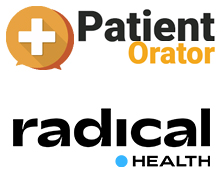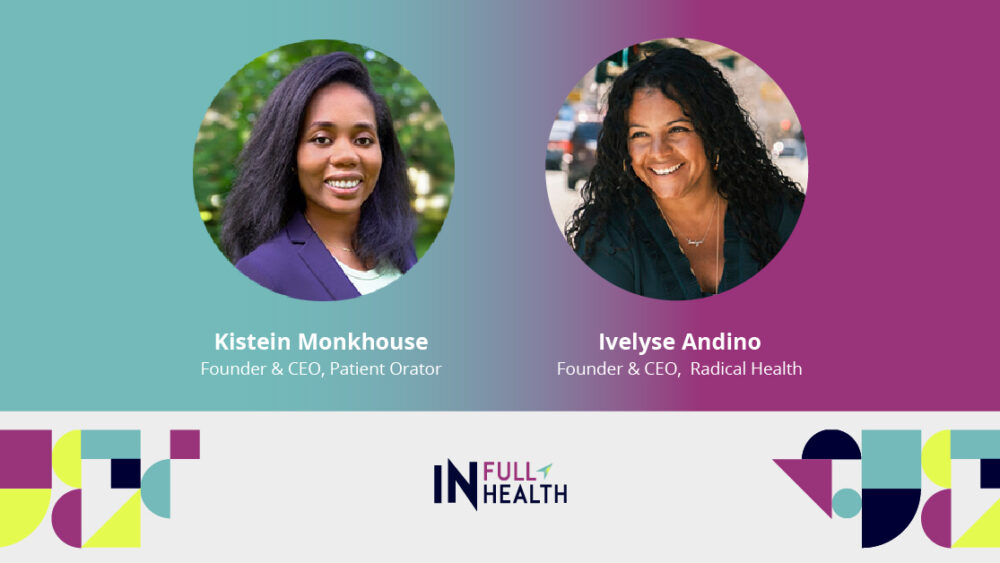 Patient experiences and patient voices are powerful — but they are often left out of health care and health innovation. Patient Orator and Radical Health are two digital health solutions working to change that.
Patient experiences and patient voices are powerful — but they are often left out of health care and health innovation. Patient Orator and Radical Health are two digital health solutions working to change that.
Listen as Patient Orator founder and CEO Kistein Monkhouse, MPA, and Radical Health founder and CEO Ivelyse Andino share their personal experiences in the health care industry, their dedication to the patient voice, and their advice for solution developers.
HEAR THE AUDIO
TRANSCRIPTION
KISTEIN MONKHOUSE: Hello, my name is Kistein Monkhouse. I am the founder and CEO of Patient Orator. My pronouns are she and her.
IVELYSE ANDINO: Hi, my name is Ivelyse Andino, and I am the CEO and founder of Radical Health. My pronouns are she, her, and ella.
Today, we’re so excited to discuss our work, mission, and personal experiences when it comes to patient voices with the In Full Health Learning & Action community.
Kistein, it has been lovely getting to know you and see your journey from the beginnings of Patient Orator to today, and I’m sure for many people listening today, they want to know more. So how does Patient Orator work and how is it breaking down barriers to quality care?
KISTEIN MONKHOUSE: Our mission at Patient Orator is to improve health outcomes by providing culturally competent communication tools to patients and their providers at their fingertips, regardless of a person’s race, ethnicity, gender identity, nationality, or insurance status.
Think of it as a safe digital diary in which you are provided a format to document how you feel in real-time. The goal of doing so is that it helps you to remember what that problem is so that when you do visit with your doctor, you have that history that is curated by yourself to help you point out what your needs are from a medical and social standpoint.
Kistein Monkhouse, MPA
Founder and CEO, Patient Orator
Radical Health is also working to engage people where they are, to boost health literacy, and to improve health outcomes. I’m curious — how do you utilize both digital technology and person-to-person connections to do this?
IVELYSE ANDINO: For us at Radical Health, our people-to-people conversations are what we lead with. We use indigenous-style circles, so people are coming together, peers chatting with one another — creating basically the space that we often don’t have between our work and our home where we can talk about our health issues, do mental health check-ins, think about long covid and cancer. And we use those conversations as a baseline for people to have the support they need to learn from one another and to really feel connected through this journey.
Whether it’s asking for a translator or asking for a second opinion. Or in the case where you feel like you’re really not being heard, Radical Health is there to listen and to support you.
In both of our work, the patient or community voice is so powerful, but it’s often left out of these conversations about health care. How did centering the patient’s voice impact your process of creating Patient Orator, or how does it impact your day-to-day work?
KISTEIN MONKHOUSE: That is a great question, Ivelyse. I knew that there was a problem in terms of health care disparities when I worked on the front lines of health care. I would hear these themes, and I saw them again when I transitioned to care coordination. I saw them once again as I was, you know, filming Humanizing Healthcare, traveling around the country.
So, these themes around what poor patient experiences are, they travel across different socioeconomic statuses for individuals. So, when it comes to centering the work of Patient Orator, around the patient voice — Patient Orator exists because I’ve listened to the patient voice, right? It exists because I saw the gaps in care firsthand while working on the front lines.
Once I started building the technology itself, the process of including the patient voice for feedback, for making sure that we’re asking the right questions, that the technology resonates with the individuals that it’s intended to be used for — that was all a part of that process, and very much intentionally so — to make sure that the patient voice is not left out of the conversation.
What about you, Ivelyse?
SUBSCRIBE
Stay in the loop about new blog posts from equitable health innovation leaders, helpful resources and tools to help you bring the Principles to life, upcoming events, and more by joining our email list.
SUBSCRIBEIVELYSE ANDINO: At Radical Health, we started — I literally started — by sitting around the table listening to people. And I say people generously and intentionally because it was everyone from my cousins, my neighbors, to people I met on the street, to doctors and nurses and administrators.
The work literally began centering people and their experiences, but also not just what they needed, but what they wanted. Their dreams, the future, how they would reimagine help to be for them in an ideal world.
At its core, everything we do from our circles to our chat centers around elevating and amplifying people’s experiences, not just so that they’re heard, but so that actual changes can be made within our existing health care system — to see the system that we want for the future. One that is equitable and generous, caring, and actually sees us all thriving.
![]()
Expressing Gratitude
I am incredibly grateful to every single person who has trusted me and Radical Health with their stories and trusted us to be their reliable source for health care. I also want to thank all of my peers, specifically all of the Black women, who do this work day in and day out, and still find time to encourage me, support me when I’m crying, bring joy, bring life, and most importantly to allow me to be bold and brave in this work.
Ivelyse Andino
Founder and CEO, Radical Health
KISTEIN MONKHOUSE: Being an Afro-Latina woman, how has your experience personally intertwined with the work that you’re doing and impacted the work that you’re doing at Radical Health?
IVELYSE ANDINO: The work at Radical Health was literally inspired and really still goes today based on my position of intersectionality. To be Black and to be Latina. To have worked inside the health care system, launching some of the largest oncology drugs, but also live in the Bronx, which was the poorest congressional district.
I’m an American citizen, but I’m from Puerto Rico, which is an existing colony — all of these positions where I see dualities, I see the intersections, and I’m able to see perspectives that often are ignored.
My superpower of being who I am, bringing my culture, my lived experiences, really allows me and the work that we do at Radical Health to do the same for others, to do the same for our communities.
Ivelyse Andino
Founder and CEO, Radical Health
And Kistein, we’ve had some of these conversations. It’s probably something that we talk about often, but what about you? How have your experiences impacted Patient Orator?
KISTEIN MONKHOUSE: So, I’m a Black woman, I am an immigrant, and I exist in society, not just as these identities, but in other roles that I take on and other aspects of myself that may not be visible.
I saw a fragmented care system that didn’t care about the everyday Joe or the everyday Mary. I really wanted to make a difference in regard to how people are treated and to make care more accessible, but easier for people to navigate. That’s why Patient Orator was founded — and in that journey I became ill.
I was diagnosed with uterine fibroids — which that diagnosis took 3 years to get to. A total of seven different doctors before I would get to that place. So, while publicly I was advocating for the rights of patients, on a private level, my own voice was not being heard in my doctor’s appointment.
So, that is a very heavy, heavy question for me because it ties back to my very existence and the pain and the trauma that I’ve had to live through for several years before getting to the place in which I own my voice and I know the power of my voice. I want to make sure that individuals that are experiencing Patient Orator can take that autonomy and ownership in every part of their health visit.
![]()
Expressing Gratitude
I want to send a shout-out to the people that have been laying the groundwork for moving towards equity. To those that are persevering regardless of how difficult this journey is. To the organizations and the individuals that have invited us to the table and are making space for us regardless of how competitive this space is — thank you.
Kistein Monkhouse, MPA
Founder and CEO, Patient Orator
KISTEIN MONKHOUSE: Do you have any advice for health and innovation leaders that want to intentionally center health literacy or the patient voice in their solutions? What actionable steps can these solution developers take?
IVELYSE ANDINO: It’s one thing to listen, but it’s another thing to act. And so, as you are developing solutions, be really mindful of what accountability looks like, what budget looks like, and what are the things that you have in place to then take action.
In every case, I think it requires listening. It requires honoring time and making sure that people are compensated for their time, but then it really then requires action, accountability, and transparency.
What about you, Kistein? If you were going to give some advice for people who want to center health literacy in the patient voice, what would you advise?
KISTEIN MONKHOUSE: This is a bit of a challenging question for me because I live with a chronic condition that disproportionately impacts African American women. So on a daily basis, as a leader, I’m reminded of why we need to exist and why innovation is incredibly important, especially for underserved people or people of all disproportionately underserved racial backgrounds.
I think it is as simple as hiring inclusively, promoting fairly, and advocating loudly — and I’ll leave my list there.
IVELYSE ANDINO: Kistein, I love talking with you, and I think probably one of the most valuable things that we have in this moment in time and in the work we do is each other and the community that we share in an industry that has been historically cutthroat and isolating.
It has been so beautiful to have you and many other founders, innovators, and leaders alongside us, supporting us, building us up, and asking some of the tough questions.
KISTEIN MONKHOUSE: It’s refreshing to hear that, you know, we’re not alone in this environment. As we’re pushing toward full health.
It’s been great speaking with you, learning about the work that you are doing, and I’m just so very excited for innovation and the potential it has to improve the health and well-being of people, regardless of their socioeconomic status.
SUBSCRIBE
Stay in the loop about new blog posts from equitable health innovation leaders, helpful resources and tools to help you bring the Principles to life, upcoming events, and more by joining our email list.
SUBSCRIBE


Comments are closed.